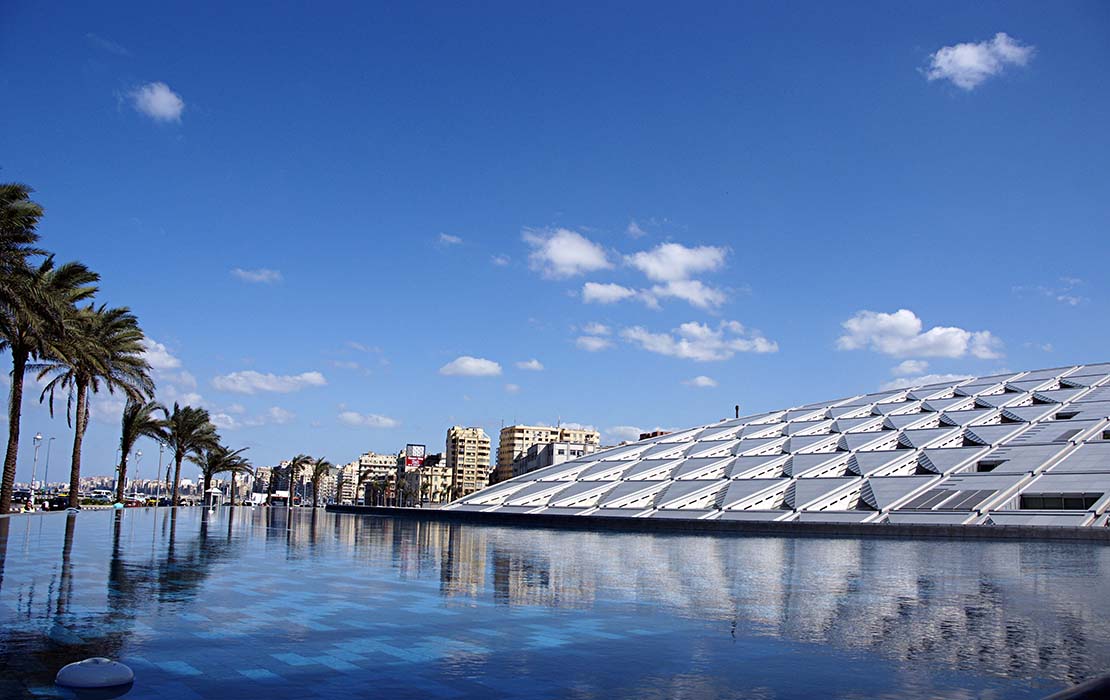Year
1994-2001Duration
7 yearsCost
£150 millionLocation
EgyptProject achievements
Connected communities
Hosts 1,500 events at the library every year, on average
Area improved
Revived the ancient library, connecting to Egypt's past
Used engineering skill
Adopted innovations in diaphragm walling
Resurrecting an ancient library in the 21st century
The Bibliotheca Alexandrina in Alexandria, Egypt is a revival of the ancient Library of Alexandria, which was built around 300BC by heirs of Alexander the Great.
The ancient library was the first universal library, hosting knowledge from scholars and artists from around the ‘known’ world.
It flourished for nearly 600 years, until it was destroyed by fire during a siege of the city in 272AD. Julius Caesar has been implicated in the library's destruction, but there's no agreement on whether it was sabotage or accidental.
Fast forward to 1972, when Mostafa El-Abbadi, a professor at Alexandria University, first suggested reviving the ancient library.
The idea was picked up and sponsored by the Egyptian government, receiving support and publicity from UNESCO.
A project agreement was signed in 1990. Built on roughly the same site as the ancient library, excavations in the area uncovered Roman villas and mosaics.
Construction began in 1994 and was completed in 2001, opening to the public in 2002.
Its design features a giant tilted disc that represents the sun rising over the Mediterranean.
The library itself boasts a planetarium, a school of library and information science, facilities to preserve rare books and manuscripts, and a conference centre.
It’s connected to the University of Alexandria by means of a footbridge.
Did you know …
-
The library contains more than 2,000 reading spaces, with the reading room’s area coming in at 20,000 m2.
-
The library is designed to host up to 8 million books, audiovisual media, maps, rare manuscripts, and more.
-
It has a design life of 200 years, with its biggest threat being the Mediterranean Sea, just 40m away.
How was the Bibliotheca Alexandrina built?
The library can host up to 8 million volumes over seven cascading levels, with the oldest volumes located in the lowest level.
Cylindrical concrete columns have been built between the terraces of each level, with skylights running diagonally between them so that daylight can filter into the room.
Books were at heart when designing this building. The geometry of the building follows the arrangement of bookshelves and reading desks, which form structural bays of 14.4m x 9.6m.
The grid is then contained in a circle, which is meant to represent the “containment of all human knowledge”, according to the project architect.
To protect the books from the environment, most of the library is underground.
The greatest feature of the library is the tilted disc on the building’s exterior, whose aluminium facing can reflect the sun and the moon, both important symbols in Egyptian mythology.
The curved wall visible beneath the tilted disk is made of grey granite and features carvings of every known alphabet in the world – a nod to the wealth of knowledge hosted within the library.
A pool surrounds the building to aid in the illumination of the library’s tilted disk.
The library’s ambitious design, the ground conditions and the intensely saline environment meant the project engineers and architects had a challenge on their hands.
Bored piling, diaphragm walling (underground structural elements), reinforced concrete rafts and construction dewatering (removing groundwater or surface water from a construction site) were among the techniques adopted to make it possible.
Difference the library has made
The library not only connects us to Egypt’s past. An ‘academic powerhouse’, it’s part of the country’s cultural and social life.
It hosts over 1,500 programmes, lectures, classes, conferences, and concerts every year, on average. This amounts to one million visitors per year.
The project had sustainability in mind. Over 80% of the construction materials were locally sourced or produced.
The interior relies on natural daylight and fresh air, and the building’s placement creates a comfortable, even temperature inside – all contributing to reduce the library’s energy needs.
People who made it happen
Owner: Bibliotheca Alexandrina
Architect: Snøhetta, Oslo
Structural design: Hamza Associates, Giza
Contractors:
- Ing. Giovanni Rodi & Co, Casalmaiocco
- Trevi Group, Cesena
- Arab Contractors, Cairo
- Balfour Beatty, London
Sources
- Bibliotheca Alexandrina - Britannica.com
- Library of Alexandria - Britannica.com
- Bibliotheca Alexandrina - Structurae.net
- Bibliotheca Alexandrina - Snøhetta
- The New Bibliotheca Alexandrina (2007)
- Temple of Learning, Building (2000)
- Back to the future - Alexandria's new world library (2002)
- Foundation and Structural Design of the Bibliotheca Alexandrina (2003)
- Alexandria Library, Egypt. In: Structural Engineering International (2000)
- Bibliotheca Alexandrina, Alexandria, Egypt: Foundation and structural design (2003)












